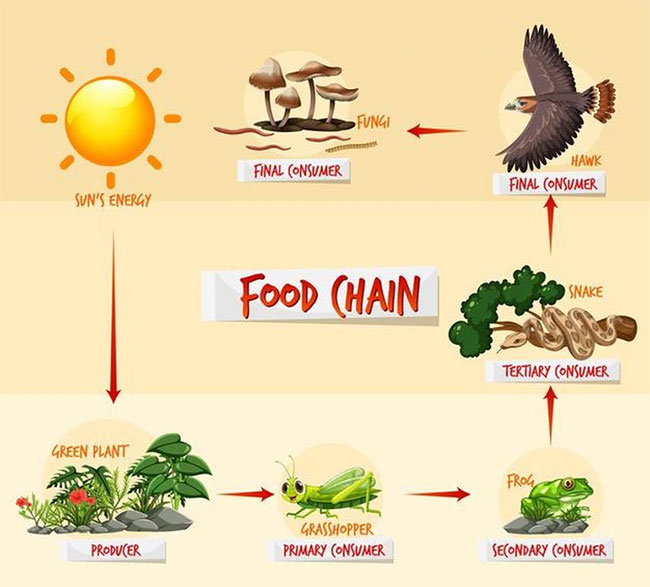If we eat the meat of top predators, does that mean humans are at the top of the food chain? This depends on our definition of “predator.”
Lions, gray wolves, and great white sharks share a common trait: they are apex predators. Their diet consists almost entirely of meat, and except for a few rare cases, these animals have no natural enemies—other than humans.
So, if we are predators of apex predators, does that mean humans sit at the top of the food chain? The answer depends on how you define “predator,” whether you are killing to eat or just killing other animals, as well as whether you consider prehistoric or modern humans.
Defining Rank in the Food Chain

A basic example of a food chain in nature. (Image: Freepik).
In ecology—the way organisms relate to one another—humans’ position in the food chain is not based on what we eat or do not eat, or on what we kill.
“It is entirely based on what you eat,” says Sylvain Bonhommeau, a marine ecologist at the Ifremer research institute in France.
“The answer is no—humans are not apex predators because we do not eat everything we kill.”
In his research, Bonhommeau and his colleagues at Ifremer have begun to define humans’ position in the food chain, also known as their trophic level. Here, scientists typically score trophic levels on a scale from 1 to 5.
By this definition, plants that capture energy from sunlight occupy level 1. Herbivores are at level 2. Species that eat only herbivores are at level 3. Species at level 4 eat only level 3 carnivores…
Species that obtain food from multiple trophic levels, like omnivores, are scored based on the average trophic level of what they eat, plus one. For example, a species that eats 50% plants and 50% herbivores would be classified as a level 2.5 omnivore.
What Rank Do Humans Hold?
Using data from the Food and Agriculture Organization of the United Nations regarding human food consumption worldwide, scientists found that on average, humans obtain 80% of their daily calories from plants and 20% from meat and fish.
This places humans at an average trophic level of 2.21—equivalent to anchovies and pigs.
However, our trophic level varies significantly around the world. For instance, in Burundi (East Africa), plants made up 96.7% of the local diet in 2009, resulting in a trophic level of 2.04 for the people of that country. Meanwhile, people in Iceland, where the diet consists of about 50% meat, have a trophic level of 2.57.
Thus, it can be seen that humans today are not actually at the top of the food chain, even though we control a large portion of food and “dominate” other species in some respects.
Conversely, humans may have once been “apex predators,” with a diet primarily consisting of meat from about 2 million years ago until around 12,000 years ago—coinciding with the end of the last Ice Age.
Prehistoric humans—according to a review published in 2021 in the American Journal of Physical Anthropology—share more physiological similarities with carnivores than with herbivores. For example, the stomachs of prehistoric humans had high acidity levels, primarily to break down complex proteins and kill harmful bacteria.
However, over time, humans began to develop technologies that allowed them to consume higher quantities of plants, such as stone tools for processing grains, followed by the advent of agriculture.


















































